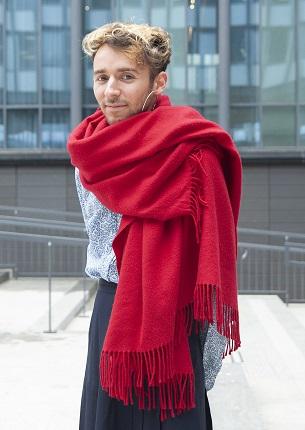
Kaspar Ravel
Digital artist and winner of the artist residency
Digital art is a vector to be current and critical
Self-taught web coder, ethical hacker and science lover, Kaspar Ravel is above all a creator who enjoys diverting new technologies to the service of art. Recently, he was chosen to be the artist in residence at Sorbonne University.
“Off the beaten track.” This expression alone could summarize Kaspar Ravel’s art. A former student of mathematics and theater at Sorbonne University, he is now a scenographer of light in the theater, a tutor in new media art ... and digital artist. Just that!
It was in the early 2000s when the Internet was slowly being deployed in homes, that Kaspar Ravel found his artistic path. "We had a family computer in the living room. I had the right to do what I wanted with it, to have fun with my session, to find flaws...". At that time, platforms such as Skyblog and MySpace abounded and were very popular with teenagers, who could shape them in their own image. "There was more computer freedom than now, we could easily play with the our blog codes. That's how I started to learn about programming, about the world of the Internet."
Little by little, this unexpected discovery turns into an insatiable curiosity. Kaspar experiments, twists and plays with the code(s). "I had, for example, hidden in the source code of an image a poem that I had written and that I wanted to keep secret. To read it, it could only be done with a text editor. By simply opening it, it modified the picture and made small deformations appear. That's when I got interested in glitch art." This visual style, which appeared at the dawn of the third millennium, aestheticizes digital accidents (code or data errors, pixelation, desaturation...) and allowed Kaspar to forge an unconventional artistic culture.
Affective artifacts or the reminiscence of nostalgia
Since 2018, Kaspar has attached particular attention to the flaws, wear and tear markers of new media, and how these marks can bring forth new feelings in us and shape our social relationships.
"The crackling of vinyl, for example, VHS filters or the grain of an image taken with a film camera, at first seen as defects, now make us feel nostalgic." These affective artifacts, as he calls them, together form a visual and sonic identity, marking every generation since the arrival of television.
But they can also have a more political role. In his latest US presidential campaign video, Donald Trump used two of them as Kaspar explains: "He employed image desaturation and image glitching to seek to represent the archaism and corruption of the then current government (ed. note: Obama's)." And to quote Marshall McLuhan, communication theorist: "The medium is the message. The nature of a medium counts more than the meaning or content of the message. For me, digital art is a vector for being current and critical.
Awarded the artistic residency
Recently, Kaspar Ravel was chosen to enter the Sorbonne University's artist residency in digital art. His project of affective artifacts will be built around the relationship between science, technological tools and materials used in research from different disciplines.
With this residency, Sorbonne University aims to renew mediation practices through the relationship between art and science. For Kaspar Ravel, joining the artistic residency means a lot: "Already, a big part of me wanted to get some kind of academic validation. As an artist, I have resided in FabLabs, in performance spaces, but never in the academic environment. I also want to do research, to investigate, to confront scientists, people who work in sociology, medicine, literature..."
Through collaborative workshops, Kaspar will bring out the emotional dimension of these artifacts produced by technology and translate them into the form of a work. "I imagine spending a lot of time in the labs, with the scientists, and asking them all the questions that bother me, participating in their experiments. I would like to focus on the issue of noise in research. There is artistic potential in every noise, artifacts everywhere. We can create stories that speak to the world today and find other narrative patterns to the scientific process."
With this artistic residency program, Kaspar Ravel wants to enhance the value of research but also take it in different directions. "Always think outside the box."
Discover the artist's work:
The website: https://www.kaspar.wtf/
The Instagram account: https://www.instagram.com/kaspar.wtf/
